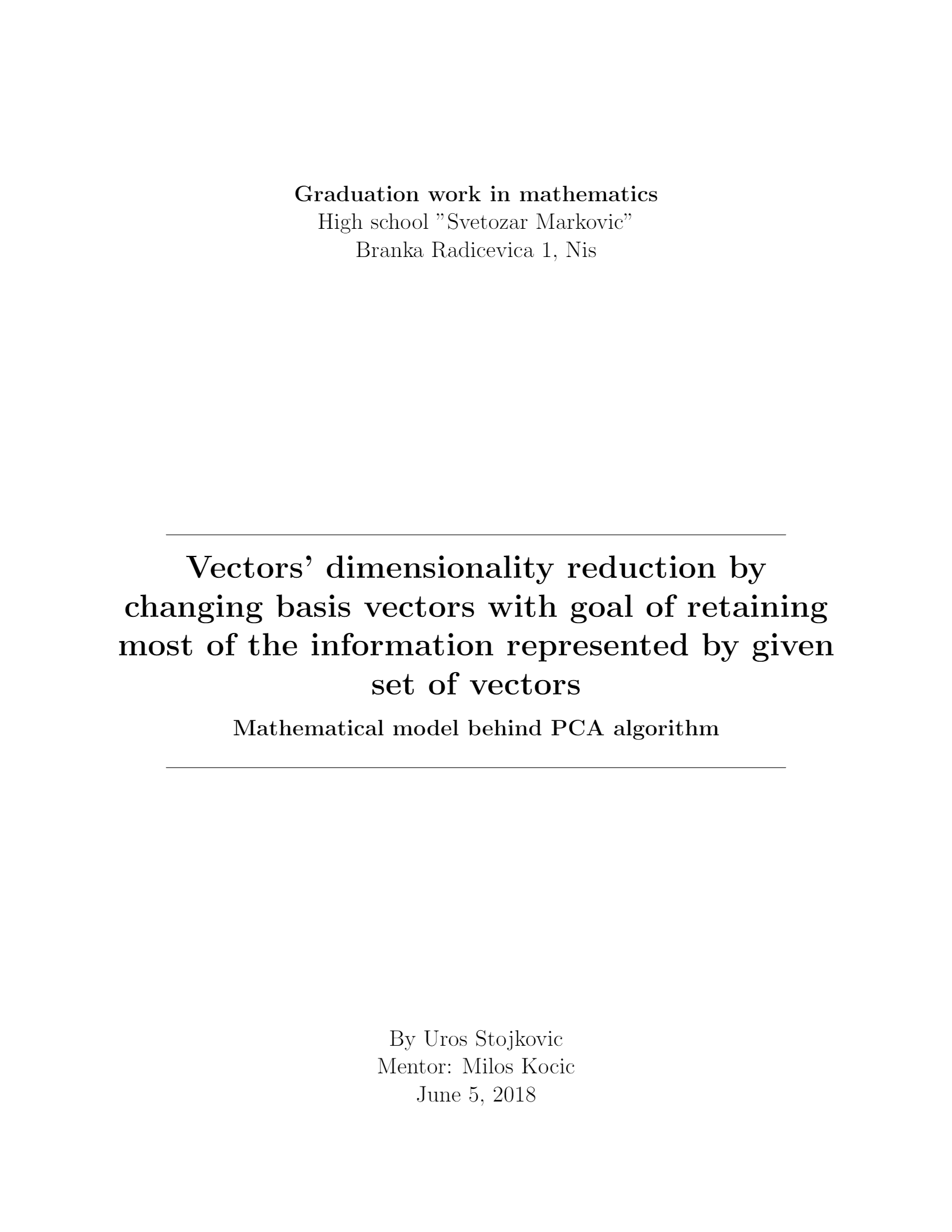Mathematical Model Behind PCA algorithm, My High School Final Paper in Mathematics
Hey folks,
I'm really excited to share with you something I've been working on for a past few weeks. The paper is about mathematical model underlying PCA algorithm and it's done in online LaTeX editor, ShareLaTeX.
 Paper cover
In Serbia, in order to graduate from high school (in USA that would be preparatory school I guess), among some other exams, you're obliged to write a final paper (graduation work) about a topic that's related to one of the subjects you studied at school. Although it's usually just a formality and it's generally not taken seriously, I, who had been exploring and studying ML and Deep Learning online (mostly at Coursera, but on Brilliant as well) during the last year, decided to put an effort to collect all the proofs and theorems I had gathered throughout the year and put it together to form a purposeful whole. Paper is broken down into a few sections: Problem defining, Mathematical prerequisites, Construction of the model, Conclusion and use in ML. My goal was to write it so that every high school student with decent math background can understand and follow.
Paper cover
In Serbia, in order to graduate from high school (in USA that would be preparatory school I guess), among some other exams, you're obliged to write a final paper (graduation work) about a topic that's related to one of the subjects you studied at school. Although it's usually just a formality and it's generally not taken seriously, I, who had been exploring and studying ML and Deep Learning online (mostly at Coursera, but on Brilliant as well) during the last year, decided to put an effort to collect all the proofs and theorems I had gathered throughout the year and put it together to form a purposeful whole. Paper is broken down into a few sections: Problem defining, Mathematical prerequisites, Construction of the model, Conclusion and use in ML. My goal was to write it so that every high school student with decent math background can understand and follow.
PCA algorithm is an unsupervised learning algorithm used for data dimensionality reduction and it's often applied before the actual supervised learning algorithms such as Artificial Neural Networks. The goal of the PCA is to significantly decrease the number of dimensions while retaining as much information given in the original data as possible. This becomes very important for the efficiency of the actual learning algorithms, especially when we talk about ANN's because of their complex architecture and vast number of calculations.
In a way, this paper also represents the summary of my work and dedication to mathematics over the last four years. Words cannot express how much gratitude I owe to Brilliant and this incredible community for my improvement in mathematics. Discovering Brilliant was for sure a milestone for me and I could've never written this paper without knowledge and deep understanding I gained here.
So, here's the link, I hope you will have fun reading it and maybe learn something new! I want to hear your impressions, critiques and suggestions in the comment section.
Cheers!
Easy Math Editor
This discussion board is a place to discuss our Daily Challenges and the math and science related to those challenges. Explanations are more than just a solution — they should explain the steps and thinking strategies that you used to obtain the solution. Comments should further the discussion of math and science.
When posting on Brilliant:
*italics*or_italics_**bold**or__bold__paragraph 1
paragraph 2
[example link](https://brilliant.org)> This is a quote# I indented these lines # 4 spaces, and now they show # up as a code block. print "hello world"\(...\)or\[...\]to ensure proper formatting.2 \times 32^{34}a_{i-1}\frac{2}{3}\sqrt{2}\sum_{i=1}^3\sin \theta\boxed{123}Comments
I never would have been doing this in high school! I didn't learn about PCA until grad school. I'm glad the internet is enabling this accelerated learning.
This is very impressive. Good job on the hard work, and congratulations on completing high school. Maybe you can add a small abstract of your thesis with this note for the uninitiated?
Log in to reply
I'm glad you like it. I added a few lines to briefly describe PCA and its importance in modern-day ML.
Sounds really interesting. I never would’ve written something so complex at such a young age. Looks like you’re the type who can apply for a writer position at essaypro and become one of their best writers in no time. A lot of other students need big, bright minds like yours. Perhaps you should consider giving it a shot?
Great job! I wish I could read the full paper. Because I fond of reading science papers. And it’s funny I hate to write essays))) Fortunately, there is an honest essay writing rating https://essaycheckup.com. I advice to use it each student who wants to find professional academic writer.